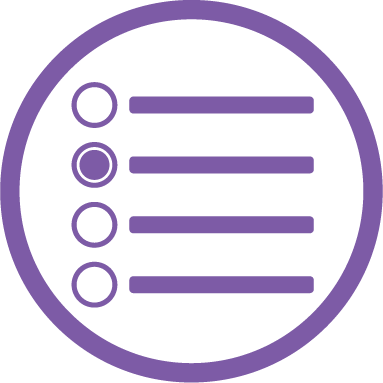
Structuring Decisions
We make multiple decisions every day; some are simple and some are complex, some we make as individuals and some as part of a group. Focusing on processes and skills for making quality decisions can improve our ability to reach decisions that work best for us in both the short and long term.
Anyone—student, parent, educator, and beyond—can benefit from structuring a decision.
Our mission is to improve lives by empowering students with essential skills and dispositions for making better decisions. We believe these skills will benefit them today and for the rest of their lives—and the society that they live in. Knowing how to structure decisions is one of the four K-12 Learning Domains of Decision Education.
Steps to Structuring a Decision
1. Framing
To accurately focus on the decision at hand, start by framing what you are, and are not, making a decision about. Consider these three components as you build your decision frame:
- Purpose: What do you want to accomplish with this decision?
- Scope: Is your frame too narrow (doesn’t address the true issue at hand) or too broad (unfocused)?
- Perspective: How might others approach this decision?
2. Clarifying Values
Making a decision must be about what you value, otherwise your decision will never fully deliver on your needs. With your frame in mind, clarify how your core values influence your outcome preferences for this decision. Keep in mind that values are personal, and can change over time. Also, what is most important to you in one decision may not be as significant in another scenario. Often, one of your values will conflict with another.
That’s why understanding your preferences is important. If you can’t pursue the option that would lead to your most valued outcome, knowing your second-best option will help guide your decision.
Remember:
- Be honest with yourself about your true priorities
- Be clear about what matters to you (this will increase the likelihood you will be satisfied with your decision)
- Your opinion about your own values is what matters
3. Generating Options
In this phase of the process, we must work to develop multiple, appealing options. In the end, you can only select from among the options you have come up with. So, it’s important not to limit yourself with an either/or point of view. Almost always, a third, fourth, or even fifth option will address more of your values. Make sure:
- They are under your control—you won’t rely on another person to execute the decision
- They are significantly different from one another
- They are attractive as an option
- They are doable—the action following a decision can actually be accomplished
4. Gathering Information
Gather more information on each of your options by tapping a variety of unbiased sources. Make sure to go beyond sites you already visit, or people whose opinion you typically rely upon. Good information often comes from sources that are not linked to politics, specific companies, or pre-defined ideas. Consider sources that are:
- Credible and unbiased
- Current and relevant (they have a meaningful impact on the decision at hand)
- Realistic about their conclusions—they allow the possibility that they could be wrong
5. Predicting Outcomes
In this part of the process, you do the math involved to figure out the option that is more likely to meet your preferred outcome. You should think about your options in terms of likelihoods, or probabilities. There are two things you are predicting. First, you imagine all of the possible outcomes that could happen for each of the options you generated. And you predict how likely each outcome is, in percentages.
Second, you determine how much you care about (value) each of the outcomes, by giving them different point values. You’ll end up multiplying the percentages by the values. The higher totals signal the best options to consider.
By predicting outcomes, we develop the discipline of acknowledging that events might not turn out the way we hope. When we combine these negative perspectives with our natural tendency to focus on positive outcomes, we can form a more realistic picture of the future.
The language of probability is especially helpful for talking about the likelihoods of certain outcomes happening. Our predictions can change from “I’ll be there on time” to “There is a 70% chance that I’ll be there on time based on the traffic conditions.” This also reminds us that the future is always uncertain, and events can have outcomes that we don’t want to expect. If there is a 70% chance we’ll be on time, we are also declaring a 30% chance that we’ll be late. Using probability to make predictions highlights the uncertainty built into the future, and we are less surprised when we get an outcome we don’t want.
6. Explaining
Being able to express why you have arrived at a particular decision indicates that you have thought through the range of possibilities for each option and have actively chosen the scenario that best fits your values, while providing the greatest likelihood of success or happiness. Explaining it is a skill all its own. It forces you to think in ways that will either confirm your conviction, or change your mind if you are presented with compelling, but contradictory, information.
7. Taking Action
Acting on a decision means behaving in ways that align with your goal and values. Create a plan that outlines the steps you must take to reach that goal and then get going! You are committed to your decision because you have clarified your values, gathered information, and predicted the possible outcomes necessary to move forward with confidence.
8. Reflecting
Once you have acted on your decision, step back and give yourself time to reflect on your use of the decision-making process. Were you honest with yourself about your values? Did you generate enough valid options?
Focus on the quality of the process, not the final outcome. Why? Because, since luck is a part of life, sometimes good decisions lead to bad outcomes, or poor decisions result in a successful outcome.
Review each part of the process to figure out what you could fine-tune. Would you make the same decision again given what you now know? Could you have known something that would have changed your decision? This post-decision analysis will strengthen your personal decision-making process and improve your future decisions.
